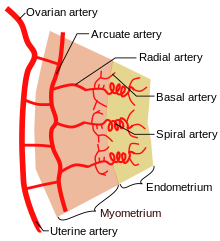Spiral artery

Spiral arteries are small arteries which temporarily supply blood to endometrium of the uterus during the luteal phase of the menstrual cycle.
In histology, identifying the presence of these arteries is one of the most useful techniques in identifying the phase of the cycle.
The spiral arteries are converted for uteroplacental blood flow during pregnancy, involving:
- Loss of smooth muscle & elastic lamina from the vessel wall.
- 5-10 fold dilation at the mouth of the vessel.
Failure of the physiological conversion of the spiral arteries can cause a number of complications, including intrauterine growth restriction and pre-eclampsia.[2]
References
- ^ Attention: This template ({{cite doi}}) is deprecated. To cite the publication identified by doi:10.1136/jcp.29.Suppl_10.9, please use {{cite journal}} (if it was published in a bona fide academic journal, otherwise {{cite report}} with
|doi=10.1136/jcp.29.Suppl_10.9instead. - ^ Burton GJ, Woods AW, Jauniaux E, Kingdom JC (June 2009). "Rheological and physiological consequences of conversion of the maternal spiral arteries for uteroplacental blood flow during human pregnancy". Placenta. 30 (6): 473–82. doi:10.1016/j.placenta.2009.02.009. PMC 2697319. PMID 19375795.
{{cite journal}}: CS1 maint: multiple names: authors list (link)
